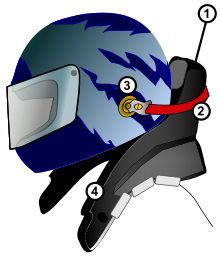All motorsport fans have heard of the HANS device, well have you actually thought about how many lives the inventor has saved? Lets just say you couldn't actually count or you'd be counting for a while.
The device was invented by Dr. Robert Hubbard in the early 1980's. A discussion with a mutual racing friend after an unfortunate incident which saw Patrick Jacquemart lose his life after a testing accident involving a sudden stop. Dr Hubbard saw a weakness during a sudden stop accident, while the body would remain in place due to the seat belts the head remained un-tethered and momentum caused the head to continue moving forward, resulting in serious injury or instant death called a Basilar skull fracture.
Dr Hubbard came up with the HANS device, which stopped the head from going forward to extremes, reducing the risk of Basilar skull fracture. At first no one was interested in the device, it took nearly 10 years and some high profile deaths of Rolan Ratzenberger, Scott Brayton and Dale Earnhardt for the device to finally set to work.

1. HANS device
2. Tether (one per side)
3. Helmet anchor (one per side)
4. Shoulder support
In the mid-90s, Mercedes Benz have decided to further develop the device in order to implement it in their Formula One programme. After further evaluation from the International Automobile Federation it became a mantatory requirement in F1 2003 and since then all major series have followed suit right down to club level. Reported sales for the device are over 300,000.
In my eyes the HANS device is one of the greatest inventions to ever come from motorsport, it has saved the lives of many drivers since it's introduction, Robert Kubica, Ernesto Viso, Kenny Bernstein and Michael McDowell to name a few (a You Tube search will prove my point) and many more.
The work of Dr. Robert Hubbard deserves to go down in history and I'm sure if you asked a driver about the device he would have nothing but praise. A truly great invention.